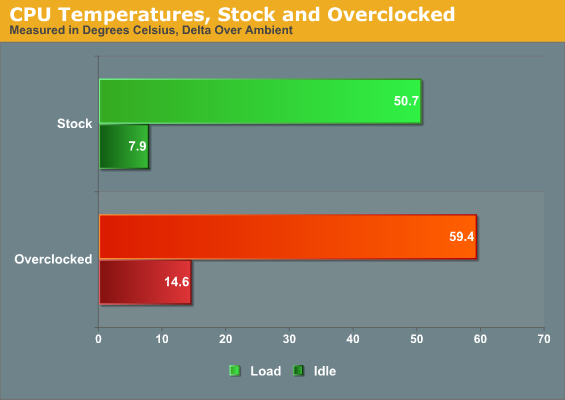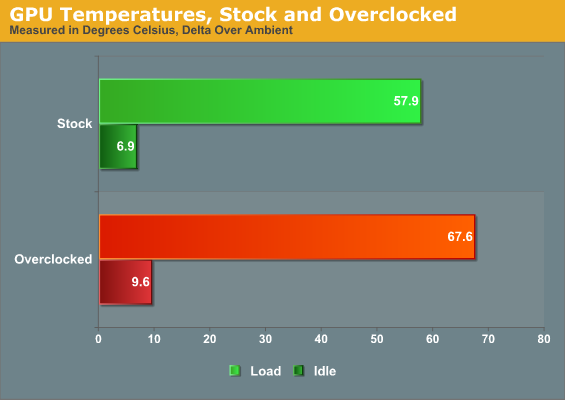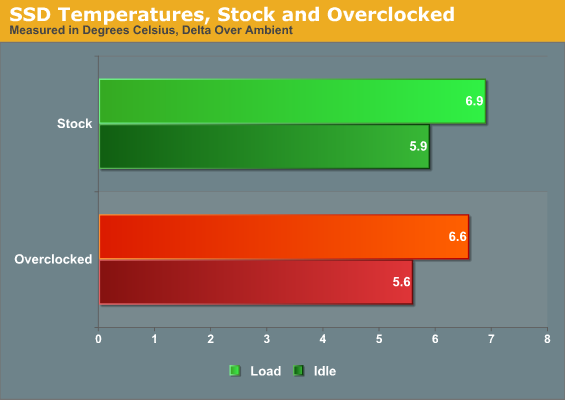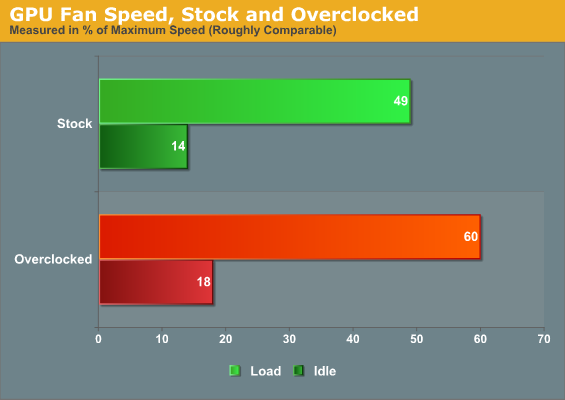Corsair Obsidian 550D: Starting to Specialize
by Dustin Sklavos on March 29, 2012 3:01 PM EST- Posted in
- Cases/Cooling/PSUs
- Corsair
- mid-tower
Noise and Thermal Testing
Since we currently only have test results for the Corsair Obsidian 550D based on our new testbed and methodology, this is going to be a relatively short breakdown. Still, there's useful information to be had.



Under the new testing rubric it can be a little difficult to figure out what's going on. First, we can see the CPU and GPU both get about a 10C increase in temperature when overclocked in the Obsidian 550D, while idle temperature increases are nowhere near as severe. The ambient temperature when testing was ~22C, which would result in absolute thermals in the 80s for the CPU...not the greatest results but not dangerous either. GPU thermals are at the 90C threshold, but when you see our fan speed results you'll see the GTX 560 Ti still has some headroom before actually overheating. Meanwhile, the SSD temperatures are within the margin of error; the increased stress from the CPU and GPU in the overclocked configuration doesn't impact the SSD in any noteworthy way.


While thermal performance isn't horrible, the fans definitely had to work reasonably hard to keep things under control. The Hyper 212 Evo's fan is virtually maxed out by the thermal load; in practical terms, the 550D in its stock configuration just doesn't seem to have that much of a ceiling for CPU overclocking. Meanwhile, the 560 Ti's fan speed gets a substantial enough jump to prove noticeable, but end users who demand more power will likely meet the limitations of the silicon itself before they hit the limits of the cooling system.

Since 30dB is the floor for our sound meter, we can safely say the Corsair Obsidian 550D is able to keep things under control while the system is idling, regardless of whether or not the components are overclocked. Under load the 550D remains very quiet; in a silent room the difference is noticeable, but in practical use it's far less likely. Unfortunately, when overclocked the 550D has a harder time keeping the noise down; the high pitch of the GTX 560 Ti's fan, in particular, makes itself known.










59 Comments
View All Comments
Nje - Friday, March 30, 2012 - link
The side panel can also fit a 200mm fan, would be interesting to see if it is possible to fit a 200mm fan and a NH-D14..stratosrally - Friday, March 30, 2012 - link
I have SLI'd GTX580s and a Corsair H60 with push/pull 120mm fans in my Scout. It is a noise machine - and that is with a custom solid side window - no vents or fans on it. I added a second 140mm intake in the 5.25"bay area under my single ODD so there are 2 front 140mm intakes, 1 top 140mm exhaust, and the 2x120mm push/pull rear =exhaust.I'd really like to try this case, the only change from as AT tested would be add an additional 120mm bottom fan next to the PSU, and keep my push/pull on the rear exhaust. I'd want to leave the solid side and top panels installed to keep noise at a minimum.
I wonder if I'd see a temp rise? My Scout is just crammed full, it has 1 SSD and 2 HDD and an audio card.
jimmyzaas - Saturday, March 31, 2012 - link
I like everything about this case except for the Front IO/power button position. If you have something plugged in to the USB port, like a usb cable for your cellphone or a usb thumb drive, you won't be able to open the door to access your optical drive or other 5.25" devices without first unplugging your device. This is just stupid IMHO.Many cases out there got this simple thing right by placing IO and buttons on TOP of the case. Why do you have to be special and put it in some ugly color-mismatched rectangular cutout in front of the case that feeds through a hole in the front door?
Sure you can remove the front door completely but why would you want to go that route? If I wanted something that looks like a Silverstone RV03, I would have bought that. I'm getting this case for the minimalistic look with the door in tact.
Death666Angel - Sunday, April 1, 2012 - link
It is, as you correctly denote in the graphs, "Degrees Celsius". Which is not "C" but rather "°C". But since you are dealing with deltas here, it would be much simpler to just use "Kelvin", "K", as most people do. :-)Thanks for making the switch to deltas though! :D
1ceTr0n - Sunday, April 1, 2012 - link
But you honestly do the worst case reviews with the worst reviewer possiblyhelvetio - Monday, April 2, 2012 - link
I just built a new system with this case and I really like it. The door can open to both sides, but the clips that allow this to happen are a bit delicate and I already broke one. Fortunately two spares are included.Since I keep the PC on the desk, it is important to me that the front ports and buttons are on the front, not on the top.
The PC is very quiet, even to my hypersensitive ears, the loudest part of the build as an evga GTX 460 but the sound proofing further lowers its noise.
Mosab - Tuesday, April 3, 2012 - link
1- From what I have seen the GC is Zotac not ASUS GeForce GTX 560 Ti DCII TOP.2- (GPU thermals are at the 90C) that is toooooo much for the GTX 560 Ti. I have GTX560Ti and I think that 90C is extreme even for over clocked one
cyberguyz - Tuesday, April 3, 2012 - link
They sink in the motherboard pan appproximately 1/4". If you are using a mATX board like the one in this article, you are fine, but if you have a full size board like an ASUS Maximus IV Extreme Z that has that lovely bank of 'lay down' SATA ports right at the edge of the motherboard, get set to break out a hammer and do some remodelling of that case.You see that raised area surrounding the motherboard pan area? It is just high enough that it blocks access the bottom-most sata ports on these motherboards. You just can't get a SATA connector into them. In short, unless you want to ding up your case to fit that really expensive full size motherboard with SATA connectors facing to the edge, I would suggest steering away from any of the Corsair Obsidian, Carbide and possibly the Graphite series cases.
As you can guess, this is from bitter experience after buying a Carbide 500R, getting it home and being faced with this conundrum.
jmunjr - Friday, April 16, 2021 - link
"but I also feel like there are large parts of it just waiting to develop issues with vibration in the future."8 years after building my system in this case it is as quiet and noise free as it was on day 1. Never an issue and never a vibration. This is the best case I have ever owned by far.